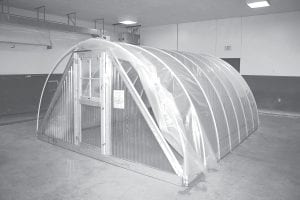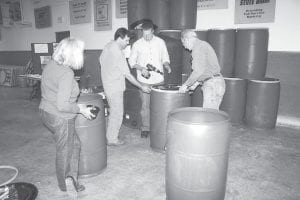The Small Footprint Living Fair June 24 and 25 delivered many innovative ideas to participants, with tours of energy efficient homes, a report on Silver Bay’s new eco-park, a guide to raising bees, and hands-on workshops on building greenhouses and rain barrels.
The keynote speaker the first day was forest certification expert and Dovetail Partners Executive Director Katie Fernholz, talking about the biomass feasibility study Dovetail is conducting on behalf of Cook County and about innovations in heating with wood.
Despite uncertainty over a grant recommended to the state legislature by the Legislative- Citizen Commission on Minnesota Resources (LCCMR), a study is moving forward on the environmental impacts and economic feasibility of using locally produced biomass for heat and potentially power in Cook County. The Cook County Board of Commissioners authorized a sizable grant that will produce the data needed to make local decisions about biomass investment.

This greenhouse was one of the attractions at the Small Footprint Living Fair July 24 and 25 at the Cook County Community Center in Grand Marais.
If the governor’s veto on the LCCMR recommendation stands, Dovetail would not be able to involve Ely in the biomass study or take the northeast Minnesota biomass story to the rest of the state. “We wouldn’t be able to dig in as deeply on environmental and economic issues as we would like to,” Fernholz added. George Wilkes of the Cook County Local Energy Project (CCLEP) said the local biomass committee is also researching the environmental impact of biomass energy.
Fernholz took questions from the audience, one of them about the impact of harvesting biomass on the nutrient level of the forest floor. Minnesota has established biomass harvesting guidelines that set standards on the amount of material that needs to be left on the forest floor to maintain the health of the forest, she said. Forester credentialing and logger certification requires training on these guidelines.
Innovations in wood burners
“If you haven’t bought a wood-burning appliance in the last 20 years, you might want to look at buying a new one, because things have changed dramatically,” Fernholz said.
In 1988, the EPA came out with particulate emission standards for indoor wood stoves, reducing the potential for air pollution dramatically. The new stoves burn wood much more efficiently, producing the same amount of heat with much less wood, Fernholz said. “[For] anyone who was splitting and stacking wood, this was good stuff!” she said.
EPA standards may continue to evolve as even newer technologies emerge. New standards set in 2007 for outdoor boilers have made older models obsolete.
Fernholz talked about a current study that is comparing the total life cycle impact of natural gas, coal, and biomass. Biomass has slightly higher emission levels than natural gas, she said, but lower levels than coal.
This year, Dovetail produced a guide for heating with wood in northern Minnesota. “Wood burning technology has improved dramatically over the last 25 years,” it states, “making wood safer, more efficient, and more convenient to use. …Today’s EPAcertified wood stoves emit 70 percent less particle pollution and are approximately 50 percent more efficient than wood stoves manufactured before 1990.”
Options available include high-tech fireplaces, outdoor boilers and central heating furnaces, catalytic wood stoves that burn smoke produced from burning the wood, masonry heaters that retain heat for up to 24 hours, and extremely low-emission pelletburning stoves with efficiency ratings of 75-90%. The exhaust gases from pellet stoves can be vented directly through a small flue pipe in a side wall or through a roof without the expense of a chimney.
Excitement over rain barrels
Dave Stark grows “ginormous” carrots in his garden in Duluth – and it’s all on account of the gray water from his house. Dave has all kinds of innovations at his house – rainwater, which he swears is the best drinking water (assuming it is collected properly to avoid contaminants), runs through his faucets, and organic waste from his garbage disposal and even his toilets is turned into compost.
Changes in water flow from residential and commercial development can negatively impact the landscape, and harvesting rainwater provides a homeowner a free source of water while potentially reducing negative impacts on the land around it.
Dave is excited about rain barrels and eager to share what he knows. He talked about options available to home and cabin owners, from 50-gallon rain barrels to 1,000-gallon cisterns and 20,000-gallon underground tanks.
Stark said about 12,000 gallons of water a year tend to fall off a 1,000-square-foot roof in northern Minnesota. Current septic system standards assume a three-bedroom house will use 600 gallons of water a day, he said, but he designs systems that use far less water than that.
Rainwater collection systems can be engineered together with other water supplies from wells and municipalities, although current state plumbing regulations haven’t caught up with the new technologies and don’t allow it. Stark expects this to change, however.
To keep rainwater fresh when a collection system is not used regularly, ozone bubblers or chlorine can be used.



Leave a Reply